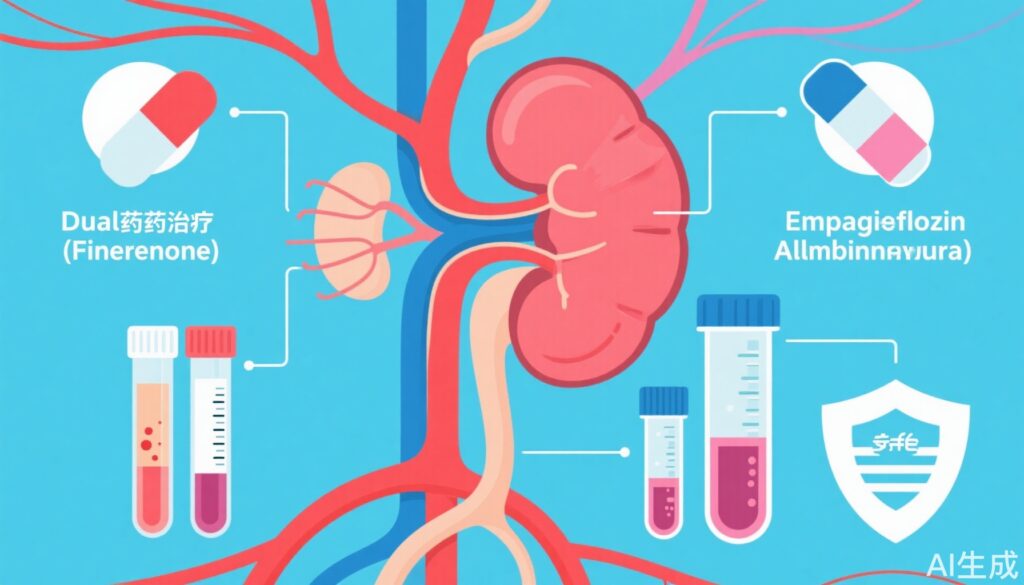Highlights
- Combination therapy of finerenone and empagliflozin results in greater reduction of albuminuria compared to monotherapy in CKD and type 2 diabetes.
- Safety outcomes were favorable, with no unexpected adverse events reported.
- The CONFIDENCE trial provides direct evidence for simultaneous initiation of these agents in high-risk patients.
Study Background and Disease Burden
Chronic kidney disease (CKD) complicated by type 2 diabetes remains a significant global health burden, driving cardiovascular morbidity, renal failure, and increased mortality. Despite advances in RAAS (renin-angiotensin-aldosterone system) blockade, residual risk persists, with proteinuria/albuminuria serving as a key indicator of progressive renal injury and cardiovascular risk. Prior landmark trials have established sodium-glucose cotransporter-2 (SGLT2) inhibitors and nonsteroidal mineralocorticoid receptor antagonists like finerenone as effective interventions for slowing CKD progression and mitigating albuminuria. However, direct evidence for their simultaneous initiation, particularly in patients already on RAAS inhibitors, has been sparse. The CONFIDENCE trial addresses this critical evidence gap, evaluating whether dual therapy provides additive renal protection without compromising safety.
Study Design
The CONFIDENCE trial was a multicenter, randomized, double-blind, placebo-controlled study. Eligible participants were adults with CKD (eGFR 30–90 ml/min/1.73 m²), significant albuminuria (urinary albumin-to-creatinine ratio [UACR] 100–5000 mg/g), and type 2 diabetes, all on stable RAAS inhibitor therapy. Randomization was 1:1:1 to finerenone (10 or 20 mg daily + empagliflozin-matching placebo), empagliflozin (10 mg daily + finerenone-matching placebo), or the combination of finerenone plus empagliflozin. The primary endpoint was the relative change in log-transformed mean UACR from baseline to 180 days. Secondary endpoints included safety assessments, notably symptomatic hypotension, acute kidney injury, and hyperkalemia leading to drug discontinuation.
Key Findings
At baseline, the three study groups had comparable median UACR values: 579 mg/g (interquartile range 292–1092), ensuring balanced renal risk profiles. At 180 days, combination therapy led to a 29% greater reduction in UACR compared to finerenone alone (least-squares mean ratio 0.71, 95% CI 0.61–0.82, P<0.001) and a 32% greater reduction compared to empagliflozin alone (least-squares mean ratio 0.68, 95% CI 0.59–0.79, P<0.001). These reductions are clinically meaningful, as UACR lowering is strongly correlated with renal and cardiovascular event reduction.
Both agents, alone or in combination, exhibited favorable safety profiles. The incidence of symptomatic hypotension, acute kidney injury, and hyperkalemia requiring drug discontinuation was low and similar across groups. No unexpected adverse events were observed, supporting the simultaneous use of finerenone and empagliflozin in this population.
Expert Commentary
The findings from CONFIDENCE are notable for the additive effect observed, supporting a mechanistic synergy between SGLT2 inhibition and mineralocorticoid receptor blockade. SGLT2 inhibitors reduce intraglomerular hypertension and tubuloglomerular feedback, while finerenone attenuates inflammation and fibrosis. Their combination targets complementary pathways, reinforcing the rationale for dual therapy in high-risk CKD patients.
Limitations include the relatively short duration of follow-up (180 days), focusing on surrogate endpoints (UACR) rather than hard renal or cardiovascular outcomes. Longer-term studies are needed to confirm sustained benefit and impact on clinical events such as end-stage renal disease or major adverse cardiovascular events.
However, given the robust reduction in albuminuria and reassuring safety profile, these results are practice-informing and should prompt guideline committees to consider dual initiation strategies in selected patients.
Conclusion
In adults with chronic kidney disease and type 2 diabetes already receiving RAAS blockade, the combination of finerenone and empagliflozin delivers superior reduction in albuminuria versus monotherapy with either agent. The evidence supports the safe and effective simultaneous initiation of both drugs, expanding the therapeutic arsenal for high-risk CKD patients. Ongoing studies will clarify long-term outcomes, but current data provide compelling support for early dual intervention.
References
Agarwal R, Green JB, Heerspink HJL, Mann JFE, McGill JB, Mottl AK, Rosenstock J, Rossing P, Vaduganathan M, Brinker M, Edfors R, Li N, Scheerer MF, Scott C, Nangaku M; CONFIDENCE Investigators. Finerenone with Empagliflozin in Chronic Kidney Disease and Type 2 Diabetes. N Engl J Med. 2025 Aug 7;393(6):533-543. doi: 10.1056/NEJMoa2410659. Epub 2025 Jun 5. PMID: 40470996.


